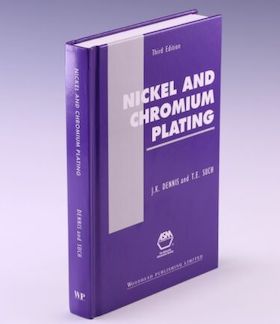
Home of the world famous 'finishing.com HOTLINE' since 1989
-----
Nickel sulfamate pH too low. How to raise?
Q. I use a new nickel sulfamate plating bath and the pH is to low, about 2.9 to 3.0. I would like to know how bring my pH to 4.0 without adding Nickel carbonate. I've read that I could dummy plate with higher temperature to favor oxygen formation. What temperature should the bath be and what current density should I use.
Please help me,
Sebastien Leclair- Ste-Foy, QC, Canada
2002
A. You do not say how large your tank is, but I would suggest turning off the filtration system and carefully adding dilute sodium hydroxide solution with a lot of stirring. Once all the nickel hydroxide has redissolved and the pH is where you want it, turn the filtration back on. I agree with you about nickel carbonate - it is a really nasty chemical and has been linked with cancer. Increasing the temperature runs the risk of breaking down the sulphamate and increasing the stress; if you plate out, you will just be wasting nickel.

Trevor Crichton
R&D practical scientist
Chesham, Bucks, UK
2002
A. I disagree with the above. Keep other ions out of the solution.
Use a slurry tank filter and feed nickel carbonate in through the filter.
After the pH is back to 4-4.2, then consider the impurities common in most commercial Nickel Carbonate and hit with 0.1%/vol Hydrogen Peroxide, powdered sulfur-free activated carbon, and filter again, then dummy.
You will have a new clean sulfamate nickel plating bath completely free of the sodium ion.

Robert H Probert
Robert H Probert Technical Services
Garner, North Carolina

2002

![]() An interesting question and pair of responses!
An interesting question and pair of responses!
Mr. Probert, your advice is always good and may well be good this time. But Trevor brought an elephant into the room with him whose presence we haven't acknowledged :-)

Ted Mooney, P.E.
Striving to live Aloha
finishing.com - Pine Beach, New Jersey
Ted is available for instant help
or longer-term assistance.
2002
Ed. note: Closely related threads include --
- letter 18923, "Why is pH is dropping/decreasing in nickel sulfamate plating bath?"
- letter 18637, "pH adjustments for nickel sulfamate plating bath"
A. Here is what I don't understand. In a normal plating bath, the pH increases due to a small amount of hydrogen evolution at the cathode. Does this not occur in a sulphamate bath? You should have to do nothing to increase the pH other than reduce the sulphamic acid addition. If the pH is dropping, it could mean that your anodes are either not dissolving properly or your anode current density is too high. This could result in oxygen generation at the anode which would consume OH ions. This would cause the pH to decrease.
I have no experience with nickel sulphamate, but in a sulphate bath, the pH normally increases.
Don Piett- Thompson, Manitoba, Canada
2003
Don,
You are mostly correct and it is the obvious answer. But, If it is a critical use, pH affects the stress and to a certain extent the hardness. At a pH of 2.9, the bath would plate out at about half the rate of a pH 4.0 (crude estimate). Also the rate of change of the pH would be much slower since pH is logarithmic. My guess is about 10 times longer than a correction from 3.8 to 4.0 .
My guess is that they made a pH correction with HCL. This avoids the addition of more nickel in a tank that already slowly generates nickel ions. Probably made a small add and only saw a tiny pH change because of the Boric Acid Buffer. They then made a percent addition and the pH fell like a rock because the buffer had completely shifted. The buffer is also a major pain in the --- when you try to raise the pH with nickel carbonate.
James Watts- Navarre, Florida
2003
A. Gentlemen,
Nickel hydroxide, to my knowledge, is perfectly suited for the purpose and does not include other metallic ions (at least in larger amounts than any other commercial salt including NiCO3). I would agree with Mr. Crichton had he recommended Nickel Hydroxide addition instead of Sodium Hydroxide.
Guillermo MarrufoMonterrey, NL, Mexico
2003
A. NiOH sounds good but is a mess. The agitation system can pick it up and cause misplates on shelf areas. It will foul a filter system faster than anything I have run across. The pH will naturally rise. If it drops, he has a much larger problem than just pH correction. Insoluble anodes and bad additions/testing are the only two things that I have come across to cause pH to drop.
James Watts- Navarre, Florida
2003
A. Sebastien ,
Ammonium solution is better addition in sulphamate nickel electrolyte for increasing the pH.
Best regards,
Nina SezinIsrael - Haifa
2003
Surely ammonium ions increase the stress in the deposit. That is why you don't want to run sulphamate at over 70 °C, as it breaks down to sulphate and ammonia.

Trevor Crichton
R&D practical scientist
Chesham, Bucks, UK
I agree with Trevor. We tested a high throw nickel sulfamate bath which contained ammonium citrate. The stress went though the roof.
Ian Yee- Austin, Texas
2003
A. Nickel oxide made into a slurry and coated on a filter will bring the pH up without adding any extraneous materials to the bath. When the desired pH is reached, remove and clean the filter.

Don Baudrand
Consultant - Poulsbo, Washington
(Don is co-author of "Plating on Plastics" [on Amazon or AbeBooks affil links]
and "Plating ABS Plastics" [on Amazon or eBay or AbeBooks affil links])
2003
New Nickel Sulfamate bath pH too low
Q. Operating a new, small desktop plating setup, with a 1 litre tank that will upscale to 5 liters ultimately. First attempts were with all-sulfamate + boric, and although a few good results were achieved (although cloudy), severe pitting started occurring after a few days of test platings. We realised a low bath pH situation; this was attributed to a lack of anode dissolution and we have since used S-Rounds.
Started again using fresh Sulfamate solution from a reputable source, the pH of the pure salt solution at 300g/l is reading between 1-2. Added Nickel Chloride 4g/l (may look to adding more, but stress being kept minimal is a major concern.) Boric at 30g/l and meter now reads pH1.7. Checked against UI paper and the value from the meter appears correct.
The solution plates reasonably, but with cloudiness and slight pitting of the surface, but operation has been at about 30 °C so far (dissolving the boric was/is tedious!); we are hoping to keep temperatures down to avoid vapourisation and then additional health and safety concerns (although IMO we have very adequate ventilation/extraction). Still have brighteners to look at; intend to use Saccharin, although typical sources are the sodium salt and this I believe will increase stress? A manual post-polish is acceptable rather than a higher temperature.
Advice would be very much appreciated: Why might pH be so low in a new bath? Do temperatures really have to be around the 50 °C mark? Is a brightener a must and Saccharin suitable?
Much obliged,
- Scarborough, UK
August 19, 2013
A. You cannot control a one liter solution "after a few days". We do not know what you mean by 300 gm/L but you want 10 ±2 oz/gal of "metal". If you are using S-rounds you only need less than 1/2 oz/gal of NiCl, any more and you got high tensile stress. The boric, acid solubility is a function of temperature, you want 6 oz/gal at 120 °F (50 &C) -- one degree fall off and some boric precipitates and causes roughness. Low boric can be one reason for pitting. At a pH much under 3.5, especially at your 1.7, the sulfamate radical breaks down into the ammonium ion (read brittleness) and sulphate. Come back to us with at least a 10 gallon solution and tell us more about what you are trying to achieve.

Robert H Probert
Robert H Probert Technical Services
Garner, North Carolina

August 22, 2013
Q. ...information received since my original post: the Nickel Sulphamate is supplied with an intentional excess of sulphamate ions as this is preferred by some of their electroforming customers. This surprises me greatly; I have seen no reference to any Nickel plating process that in carried out at below pH 2. Perhaps someone may enlighten me?! Fortunately also, the company will supply with a specified pH, which will avoid having to introduce problem additives, health or stress related.
My question still remains regarding the temperature, and I also would appreciate if anyone might recommend their choice of brighteners/levelers? We have planned to avoid raised temperatures to prevent significant vaporisation & thus operator exposure (although easily eliminated with the purchase of another fume hood, but this is also wished avoided).
Regards,
- Scarborough, UK
August 23, 2013
One thing you might consider is a wetter; sulfamate baths generate H2 gas and bubbles can stick to the cathode surface.
Go commercial on a brightener and wetter; your life will be easier.
To raise pH you can add NiCO3, amount to be determined empirically.

James Totter, CEF
- Tallahassee, Florida
August 23, 2013
A. The initial pH is low because the makeup contains an excess of sulfamic acid.
In normal operation the pH of the nickel bath will increase because the anode efficiency is greater than the cathode efficiency. Perhaps the excess acid was added to help keep pH at 4
The plating rate and cathode efficiency go down as the pH goes down. You need to be near pH 4 to get rid of most of the gas bubbles and have low stress.
If brightness is not a problem you can use either saccharin or NTSA as a grain refiner and stress reducer. Be careful not to use too much since high concentrations will cause high compressive stress which can be worse then high tensile stress
I suspect your solution is cloudy because the boric acid is too high for the temp you are using. I have found boric acid concentrations of 30 g/l work well and do not precipitate out of solution as the temp gets lower. this concentration does not cause any pitting Many of my clients operate at approx. 110 °F to get minimal COE changes between mandrel and electroform.

Pat Mentone
St Paul, Minnesota
August 24, 2013
A. Ammonia addition is a no no.
The question is how did you get such a low pH? Probably tried to lower the pH and overdosed it.
Bear in mind that the pH normally decreases ^increases with operation so if you do not want to use any additives, just dummy plate (with regular current density, not a low current density as when you dummy plate to reduce metallic impurities).

Sara Michaeli
Tel-Aviv-Yafo, Israel
October 17, 2013
A. Hello David,
A lot of good information was mentioned for you. James Totter and Pat Mentone had good answers. I have to disagree with Sarah however. The pH of the solution will increase with normal use, not decrease. Dummy plating would be necessary when metallic contamination is an issue, which is not the case here. You are better off with running the bath as it was designed, as far as pH and temperature goes.
Process Engineer - Mesa, Arizona
October 21, 2013
|
Thanks Mark. Looking at the context of her answer, Sarah surely meant that "pH increases" or "acidity decreases", and simply used the wrong word :-)
Hello Ted, Process Engineer - Mesa, Arizona, USA
Hello Ted, Process Engineer - Mesa, Arizona |
A. Nickel sulphamate electroforming is quite straight forward. The optimum pH for its is 3.8-4.2, so this must be your target range. I was surprised by you very low nickel sulphamate pH and would ask your supplier to provide some at a higher pH. If you must increase the bath's pH, the conventional wisdom is to use nickel carbonate, but in recent years this has become a no-no due to its hazardous nature. I would therefore suggest you use sodium hydroxide solution and carefully add it with plenty of agitation and no filtration. I know many people are opposed to sodium hydroxide as they believe sodium increases the stress in nickel deposits, but I have never knowingly suffered from increased stress due to sodium. Some people favour nickel hydroxide, but this can be a messy process to add to the electrolyte. Never use ammonia ⇦ on eBay or Amazon [affil link] or ammonium hydroxide as this will send the nickel stress through the roof!
I personally prefer to operate nickel sulphamate at about 55-60 °C, as this is about the optimum range for it in terms of stress deposition rate etc. Do not go over 70 °C with sulphamate because it breaks down to sulphate and ammonia - sending the stress sky high. I am also a bit concerned about the reasons why your pH is decreasing - I suspect you are using inert anodes, so I would suggest you use "sulfur rounds" nickel; these readily depolarise and dissolve, so you replenish your nickel in the electrolyte as you go along. It also has the advantage that sulfur nickel does not need chloride in the electrolyte to promote dissolution, so the stress is again kept low (chloride induces stress in nickel electroforms). Regarding the use of sodium saccharin - this is an excellent hardener and brightener and can be used at anything from 0.1 to 5 g/l. There are alternatives available but they all have their own problems. Low saccharin values will give you a lower stress. As with virtually all nickel plating, you will need a surfactant in the bath - try to use a non-foaming one!

Trevor Crichton
R&D practical scientist
Chesham, Bucks, UK
November 11, 2013
Nickel carbonate makes sulfamate nickel plating bath murky
Q. Dear finishers,
I made up a (very small) nickel sulfamate plating bath and to raise the PH I added nickel carbonate.
This turned my clear emerald green bath murky. Is that normal and can I proceed with this or would you advise to treat with peroxide and filter through activated carbon? The nickel carbonate was laboratory grade, assuming that this is pure?
Thanks in advance,
Wesley

Wesley van de Ven
- Weert, Netherlands
March 3, 2014
A. If you did not add too much, it will eventually dissolve and return to clear. If you added too much then the pH went too high and the sulfamate radical broke releasing ammonia and the solution is destroyed (becomes a nickel sulphate solution). Take out a Liter, filter it (NOT WITH CARBON). Titrate the solution that comes thru the filter for metal, chloride, and pH, adjust those parameters, and do a plating test in a Hull Cell ⇦ huh? or a beaker [beakers on eBay or Amazon [affil link] . then you will know what to do. Next time you need to raise the pH, try it in a beaker first to determine approximately how much nickel carbonate is required.

Robert H Probert
Robert H Probert Technical Services
Garner, North Carolina

March 7, 2014
Q. Hello Robert,
Thank you for your reply. I have been checking the ph while adding nickel carbonate and after a day it wasn't over 4,3. I don't think I added too much. However, when I turned off my agitation, the bath was clear again after a few hours? Leaving some sediment at the bottom. Turned murky again when I switched on the agitation. Tried to plate a test piece and that came out rough and blotchy. What could it be?

Wesley van de Ven [returning]
- Weert, Netherlands
March 7, 2014
A. I can only guess that the stuff in the bottom, that keeps getting stirred back up by the air, is undissolved nickel carbonate and/or the impurities common in commodity nickel carbonate. In our country it is very difficult to find commodity nickel carbonate that is pure enough to use in high purity nickel sulfamate plating solutions. A particular impurity we frequently encounter is lead (Pb). Decant, throw out the sediment on the bottom, filter back in, titrate, adjust, run a plating test. Try the commodity nickel carbonate in the Hull Cell versus a batch of reagent grade nickel carbonate, note the difference.

Robert H Probert
Robert H Probert Technical Services
Garner, North Carolina

March 10, 2014
![]() Thanks Robert. I suppose that that could explain why my pH was rising slowly as well. The nickel carbonate I bought was quite cheap and the seller said it works fine for plating but I got some better stuff now that's >99% pure. Will run some tests as you recommended. Thanks again.
Thanks Robert. I suppose that that could explain why my pH was rising slowly as well. The nickel carbonate I bought was quite cheap and the seller said it works fine for plating but I got some better stuff now that's >99% pure. Will run some tests as you recommended. Thanks again.

Wesley van de Ven [returning]
- Weert, Netherlands
March 13, 2014
No dead threads!
Your Q, A, or Comment puts this thread on The Finishing.com HOTLINE.
